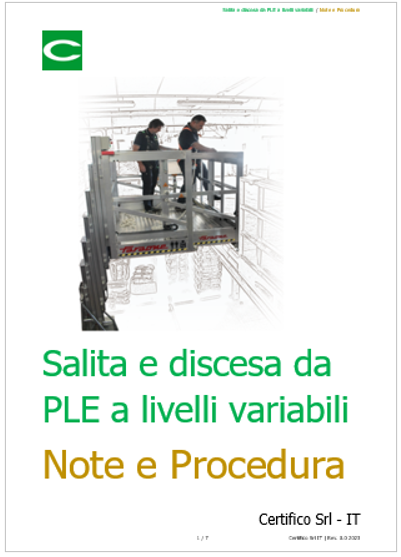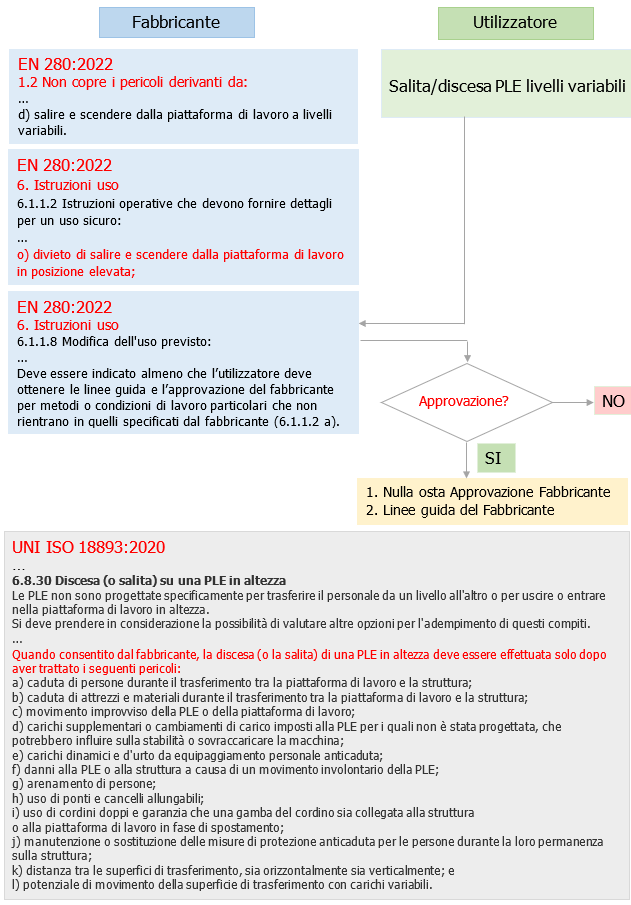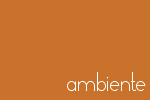
Salita e discesa da PLE a livelli variabili / Note e Procedura
ID 19837 | 18.06.2023 / Documento completo allegato
Si riportano note e procedure illustrate in riferimento alle norme:
UNI N 280-1:2022 - Piattaforme di lavoro mobili elevabili - Parte 1: Calcoli per la progettazione - Criteri di stabilità - Costruzione - Sicurezza - Esami e prove
UNI ISO 18893:2020 - Piattaforme di lavoro mobili elevabili - Principi di sicurezza
________
La norma UNI EN 280-1:2022, Piattaforme di lavoro mobili elevabili - Parte 1: Calcoli per la progettazione - Criteri di stabilità - Costruzione - Sicurezza - Esami e prove, armonizzata per la Direttiva macchine 2006/42/CE di tipo C, detta i requisiti di sicurezza per i Fabbricanti di PLE.
Nel campo di applicazione della Norma p. 1.2, è previsto che la norma non copre il pericolo della salita e discesa dalla PLE a livelli variabili, seppur il Fabbricante debba specificarne il divieto nel Manuale d’Istruzioni (p. 6.1.1.2 o).
Sempre al Cap. 6. Istruzioni per l’Uso, p. 6.1.1.8, è previsto che il Fabbricante deve indicato almeno che l’utilizzatore deve ottenere le linee guida e l’approvazione del fabbricante per metodi o condizioni di lavoro particolari che non rientrano in quelli specificati dal fabbricante (6.1.1.2 a), tra cui, appunto, la salita e discesa dalla PLE a livelli variabili.
L’autorizzazione da parte del Fabbricante può anche essere negata, in quanto la macchina non è stata costruita analizzando tale pericolo (non previsto dalla norma), in quanto legato a specifici contesti che possono non essere individuabili e valutabili (configurazioni della macchina, condizioni di carico, ambientali, ecc).
Nel caso di autorizzazione concessa, il fabbricante deve fornire:
1. Approvazione
2. Linee guida
Quindi, quando consentita tale modalità di utilizzo, oltre a linee guida specifiche del Fabbricante condivise con Utilizzatore a cui speeta anche una specifica valutazione dei rischi, utile è prendere in esame quanto previsto dalla norma UNI ISO 18893:2020 Piattaforme di lavoro mobili elevabili - Principi di sicurezza, ispezione, manutenzione e funzionamento,al p. 6.8.30 Discesa (o salita) su una PLE in altezza sono riportati i pericoli da trattare prima di tale utilizzo.

Si riepiloga la nota con lo schema di Fig. 1

Fig. 1 - Schema Fabbricante / Utilizzatore per la salita/discesa PLE livelli variabili
_______
UNI EN 280-1:2022
1.2 This document is applicable to the structural design calculations and stability criteria, construction, safety examinations and tests before MEWPs are first put into service. It identifies the hazards arising from the use of MEWPs and describes methods for the elimination or reduction of these hazards.
It does not cover the hazards arising from:
a) use in potentially explosive atmospheres;
b) work from the platform on external live electric systems;
c) use of compressed gases for load bearing components;
d) getting on and off the work platform at changing levels;
e) specific applications (e.g. railway, ships) covered by National or local regulations.
6 Information for use
6.1 Instruction handbook
6.1.1 General
6.1.1.1 The manufacturer or his authorized representative established in the EU shall draw up an instruction handbook complying with EN ISO 12100:2010, 6.4.5. Instructions for maintenance operations which are to be carried out only by specialist maintenance personnel shall be separated from the other instructions.
The manufacturer shall provide a test report detailing the overload and functional tests carried out by the or for the manufacturer or his authorized representative.
The instruction handbook shall include the following information:
6.1.1.2 Operating instructions which shall give details for safe use, e.g.:
a) characteristics and description of the MEWP and intended use (including the access position(s));
b) information about setting up the MEWP, e.g. maximum permitted slope(s) for operation and travelling and the applied forces created by the stabilizers/wheels;
c) location, purpose and use of all controls (including duplicate, see 4.7.4), auxiliary system (see 4.7.8) and emergency stop function (see 4.7.5) including conditions for when they remain active, overridden or are not operational;
d) prohibition of overloading the work platform;
e) prohibition of use as a crane;
f) national traffic regulations;
g) keeping clear of live electric conductors;
h) avoidance of contact with fixed objects (buildings etc.) or moving objects (vehicles, cranes, etc.);
i) prohibition of any increase in reach or working height of the MEWP by use of additional equipment, e.g. ladders;
j) prohibition of any addition that would increase the wind loading on the MEWP e.g. notice boards (for exception, see 4.2.3.5);
k) environmental limitations (see 4.8.1 b) and c));
l) information on vibration. This shall include the highest root mean square value of weighted acceleration to which the whole body is subjected, if it exceeds 0,5 m/s2. Where this value does not exceed 0,5 m/s2, this shall be mentioned;
m) important pre-use checks on the safe condition of the machine (oil leaks, loose electrical fittings/connections, chafed hoses/cables, condition of tyres/brakes/batteries, collision damage, obscured instruction plates, special safety devices/functions, etc.);
n) installation of removable guard-rails;
o) prohibition of getting on and off the work platform when elevated;
p) precautions for travelling with elevated work platform;
q) precautions for travelling with crawler machines;
r) approved exchangeable work platforms;
On MEWPs of group A type 1, 2, 3 and group B type 1, information for use shall be provided to reduce the risk of trapping or crushing injury to the hands of persons not operating the controls. This information shall be given in the form of either operating instructions in the instruction handbook and/or a decal or
marking on the platform.
s) guidance on the use of personal fall protection systems, which are intended for use on the MEWP;
t) the operating method to be followed in the event of accident or breakdown; if a blockage is likely to occur, the operating method to be followed so as to enable the equipment to be safely unblocked;
u) the operating method to be followed for rescuing an incapacitated operator on the platform;
v) the specification of spare parts to be used, when these affect the health and safety of operators;
w)
- the A-weighted emission sound pressure level at the specified workstation(s) as determined according to M.1 when this value exceeds 70 dB.
- If the A-weighted emission sound pressure level does not exceed 70 dB this fact should be stated.
- The sound power level determined according to M.2, where relevant.
x) identification of materials that require special means of disposal and advice on the means of disposal (see EN ISO 12100:2010, 6.4.5.1 b)).
6.1.1.8 Modification to the intended use:
At least advice shall be given that the user shall obtain the guidance and approval of the manufacturer in the event of any special working methods or conditions which are outside those specified by the manufacturer (see 6.1.1.2 a)).
_______
UNI ISO 18893:2020
6.8.30 Discesa (o salita) su una PLE in altezza
Le PLE non sono progettate specificamente per trasferire il personale da un livello all'altro o per uscire o entrare nella piattaforma di lavoro in altezza. Si deve prendere in considerazione la possibilità di valutare altre opzioni per l'adempimento di questi compiti.
I regolamenti locali dovrebbero essere considerate anche in relazione alla discesa o alla salita di una PLE in altezza.
Quando consentito dal fabbricante, la discesa (o la salita) di una PLE in altezza deve essere effettuata solo dopo aver trattato i seguenti pericoli:
a) caduta di persone durante il trasferimento tra la piattaforma di lavoro e la struttura;
b) caduta di attrezzi e materiali durante il trasferimento tra la piattaforma di lavoro e la struttura;
c) movimento improvviso della PLE o della piattaforma di lavoro;
d) carichi supplementari o cambiamenti di carico imposti alla PLE per i quali non è stata progettata, che potrebbero influire sulla stabilità o sovraccaricare la macchina;
e) carichi dinamici e d'urto da equipaggiamento personale anticaduta;
f) danni alla PLE o alla struttura a causa di un movimento involontario della PLE;
g) arenamento di persone;
h) uso di ponti e cancelli allungabili;
i) uso di cordini doppi e garanzia che una gamba del cordino sia collegata alla struttura
o alla piattaforma di lavoro in fase di spostamento;
j) manutenzione o sostituzione delle misure di protezione anticaduta per le persone durante la loro permanenza sulla struttura;
k) distanza tra le superfici di trasferimento, sia orizzontalmente sia verticalmente; e
l) potenziale di movimento della superficie di trasferimento con carichi variabili.
...
segue in allegato
Certifico Srl - IT | Rev. 0.0 2023
©Copia autorizzata Abbonati
Info e download
Collegati
UNI EN 280-1:2022 - Piattaforme di lavoro mobili elevabili
UNI ISO 18893:2020 | Piattaforme di lavoro mobili elevabili
Direttiva macchine 2006/42/CE
PLE nei cantieri
Guida di buona prassi PLE - IPAF

























